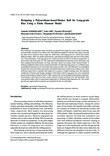Designing a Polyurethane-based Husker Roll for Long-grain Rice Using a Finite Element Model
Japan Agricultural Research Quarterly
| ISSN | 00213551 |
|---|---|
| NII recode ID (NCID) | AA0068709X |

Full text
jarq55-3_245-251.pdf877.57 KB
Rice husking is an operation where the husks are peeled from rough rice, and a rubber roll husker conventionally consists of two rubber rolls with different peripheral velocities that rotate to provide the shear stress needed to husk rough rice. Both short- and long-grain rice, which have totally different shapes, affect rice husker performance, especially the husking ratio and wear of the husker roll. The performance with long-grain rice, which accounts for 80% of world rice production, is poorer than with short-grain rice. We analyzed the fundamental mechanisms of the roll husker, and then compared the performance for long- and short- grain rice using a finite element model. A husking simulation based on the constructed model revealed that long-grain rice exhibited more accumulated friction loss (121.6 mJ) than short-grain rice (40.1 mJ). The difference in accumulated friction loss at the roll surface may lead to increased friction heat, which in turn induces wear. Since sufficient shear force is needed with rough rice to achieve a higher husking ratio, the optimum coefficient of friction and Young’s modulus of the husker roll for long-grain rice were calculated based on the model as being 0.8 and 8.1 MPa, respectively. Newly designed polyurethane-elastomer-based husker rolls based on these results showed a better husking ratio and durability than conventional rubber rolls in experiments undertaken in Thailand using long-grain rice. The results provide new opportunities to prepare new materials for the rice roll husker.
| Date of issued | |
|---|---|
| Creator | Tadashi YOSHIHASHI Yuki ABE Nariaki IWASAKI Hiroyuki SAKANAKA Masatoshi FUJINAKA Ryuichi KIDO |
| Subject | accumulated friction loss polyurethane elastomer elasticity |
| Publisher | Japan International Research Center for Agricultural Sciences |
| Received Date | 2020-03-19 |
| Accepted Date | 2020-09-29 |
| Volume | 55 |
| Issue | 3 |
| spage | 245 |
| epage | 251 |
| DOI | https://doi.org/10.6090/jarq.55.245 |
| Language | eng |
